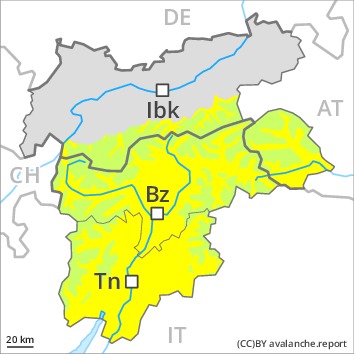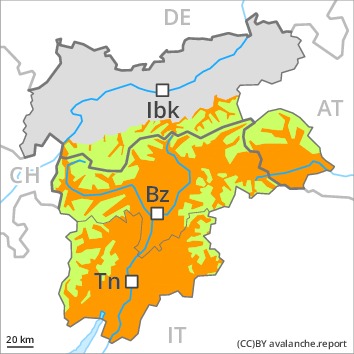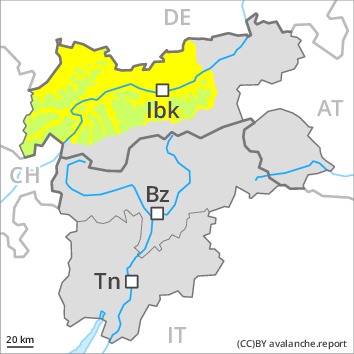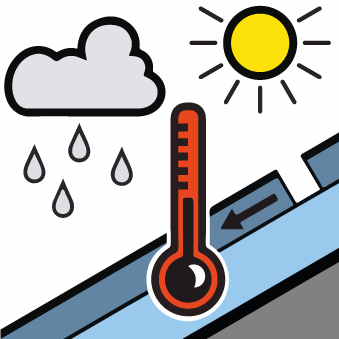AM

Danger level
 | 2600m
|
Avalanche Problem
PM

Danger level
 | 2800m
|
Avalanche Problem
Wet avalanches as the day progresses.
As a consequence of warming during the day and solar radiation more wet and gliding avalanches are to be expected. This applies especially on very steep sunny slopes below approximately 2800 m, as well as on steep east and west facing slopes below approximately 2400 m. Avalanches can release the wet snowpack and reach large size. Exposed parts of transportation routes are endangered in isolated cases. Wet avalanches can in some places be released by a single winter sport participant. Backcountry tours should be concluded timely.
Dry avalanches can be released in deeper layers in very isolated cases, especially at transitions from a shallow to a deep snowpack. In addition the older wind slabs are prone to triggering in isolated cases still. The avalanche prone locations are to be found in particular on very steep shady slopes above approximately 2400 m and adjacent to ridgelines. Such avalanche prone locations are very rare.
Snowpack
dp.10: springtime scenario
dp.2: gliding snow
Outgoing longwave radiation during the night will be good over a wide area. The snowpack is moist and its surface has a melt-freeze crust that is strong in many cases. The spring-like weather conditions will give rise to increasing and thorough wetting of the snowpack, in particular on steep sunny slopes below approximately 2800 m, as well as on shady slopes below approximately 2000 m. The surface of the snowpack will soften earlier than the day before, in particular on east and west facing slopes especially below approximately 2400 m.
Isolated avalanche prone weak layers exist in the centre of the snowpack on west, north and east facing slopes. As a consequence of mild temperatures and solar radiation the snow drift accumulations stabilised.
Tendency
Slight decrease in danger of wet avalanches as the temperature drops. In some regions strong foehn wind from the south.
AM

Danger level
 | 2600m
|
Avalanche Problem
PM

Danger level
 | 2600m
|
Avalanche Problem
Wet avalanches as the day progresses.
As a consequence of warming during the day and solar radiation more wet and gliding avalanches are to be expected. Caution is to be exercised in particular on sunny slopes below approximately 2600 m, as well as on steep east and west facing slopes below approximately 2400 m. Individual gliding avalanches can also be released in the night or in the morning. Wet avalanches can release the wet snowpack and reach large size. Exposed parts of transportation routes are endangered in some cases. Wet avalanches can to an increasing extent be released by a single winter sport participant, especially in areas where the snow cover is rather shallow. Between approximately 2000 and 2400 m these avalanche prone locations are more prevalent. Backcountry tours should be concluded timely.
In addition the older wind slabs are prone to triggering in isolated cases still. The avalanche prone locations are to be found in particular on extremely steep shady slopes above approximately 2400 m and adjacent to ridgelines. Such avalanche prone locations are very rare.
Snowpack
dp.10: springtime scenario
dp.2: gliding snow
Outgoing longwave radiation during the night will be good over a wide area. The snowpack is moist and its surface has a melt-freeze crust that is strong in many cases. The spring-like weather conditions will give rise to increasing and thorough wetting of the snowpack, in particular on steep sunny slopes below approximately 2600 m, as well as on shady slopes below approximately 1800 m. The surface of the snowpack will soften during the day.
Isolated avalanche prone weak layers exist in the centre of the snowpack on west, north and east facing slopes. As a consequence of mild temperatures and solar radiation the snow drift accumulations stabilised. In particular low altitudes: On steep sunny slopes only a little snow is lying.
Tendency
Slight decrease in danger of wet avalanches as the temperature drops.
AM

Danger level
 | 2400m
|
Avalanche Problem
PM

Danger level
 | 2400m
|
Avalanche Problem
Wet avalanches as the day progresses.
As a consequence of warming during the day and solar radiation more wet and gliding avalanches are possible. Caution is to be exercised in particular on east, south and west facing slopes below approximately 2400 m below approximately 2400 m. Individual gliding avalanches can also be released in the night or in the morning. Wet avalanches can in some cases be released by a single winter sport participant, especially in areas where the snow cover is rather shallow. Between approximately 2000 and 2400 m these avalanche prone locations are more prevalent. Mostly avalanches are medium-sized. Backcountry tours should be concluded timely. Areas with glide cracks are to be avoided.
Snowpack
dp.10: springtime scenario
dp.2: gliding snow
Outgoing longwave radiation during the night will be good over a wide area. The snowpack is moist and its surface has a melt-freeze crust that is strong in many cases. The spring-like weather conditions gave rise to thorough wetting of the snowpack, in particular on steep sunny slopes below approximately 2400 m, as well as on shady slopes below approximately 1800 m. In particular at low and intermediate altitudes hardly any snow is lying on south facing slopes.
Tendency
Slight decrease in danger of wet avalanches as the temperature drops.













